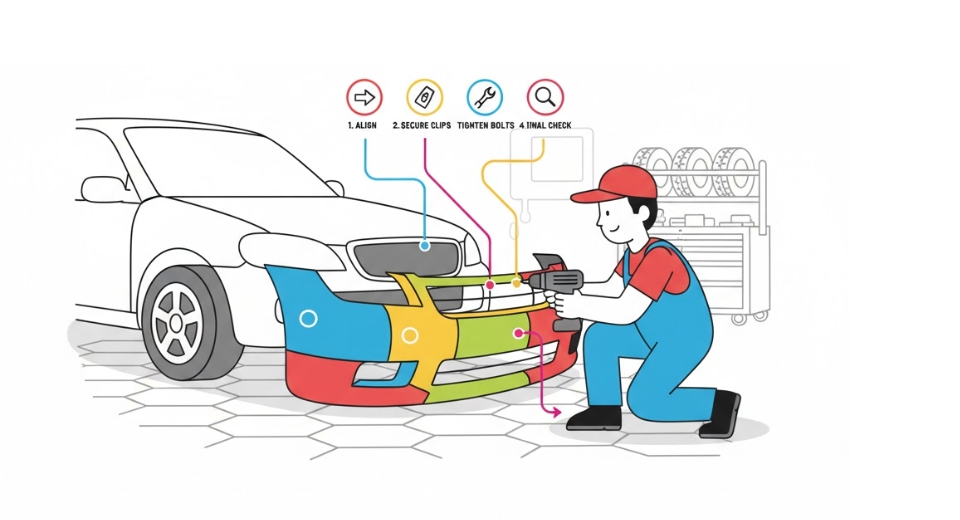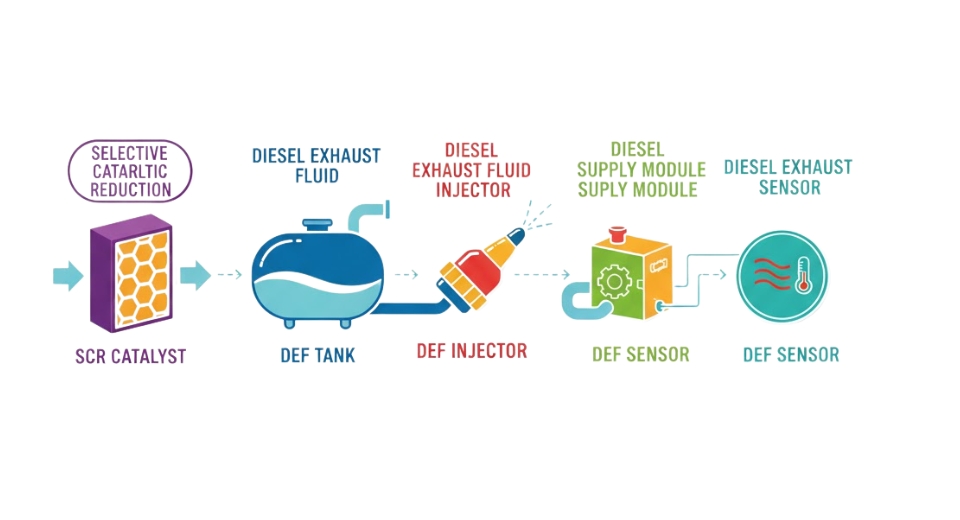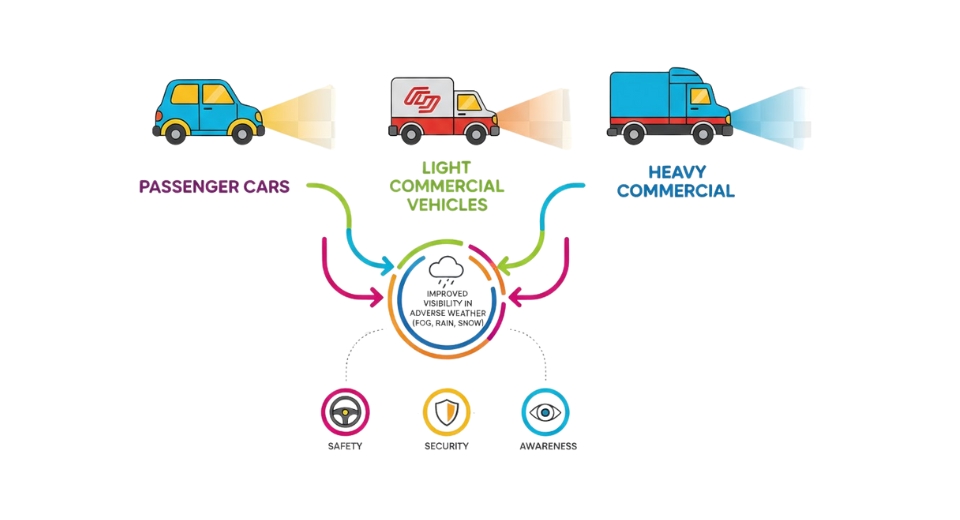MARKET OVERVIEW
The Global Automotive Steer-by-Wire System Market would produce designs into which future steering systems can integrate with other components of the vehicle for effective communication. The conventional steering column will be discarded, which will allow manufacturers ample liberty in the design of the interiors according to the technical trends in future mobility. With such developments in steering, steer-by-wire technology will avail the precision and adaptability all requisite for completely automated vehicles to operate safely and efficiently.
Revolutionizing the Conversion of Vehicles is the Global Automotive Steer-by-wire system market in which an advanced development has been adopted in the automotive industry that makes it possible to do away with the mechanical and hydraulic linkages. This type of market refers to the development and deployment of electronic steering systems, which is replacing the conventional systems with integration of sensors, actuators, and electronic control units. Steer-by-wire systems will transform the dynamics in vehicles, safety, and capabilities for autonomous driving, as automakers explore vehicles of the next generation.
The traditional steering systems were based mainly on mechanical connections between the wheels and steering wheel, and gears often provided hydraulic or electric power assistance. This focuses on the Global Automotive Steer-by-Wire System Market as the market stands focused-on removing such mechanical dependency. It offers great vehicle flexibility and performance optimization. These systems provide control of wheel movement via electronic signals and bring about fast reaction time and precise adjustment for steering, thereby reengineering how vehicles would be handling according to different road conditions and driving scenarios.
The vehicle manufacturers and technological providers would be so much interested in investing in these systems because they seem to be potentially improving efficiencies through the reduction in complexity of mechanics involved. Innovations in software algorithms and sensor integration would also play key roles in the Global Automotive Steer-by-Wire System Market for enabling seamless communication between the driver and the steering system of a vehicle. In these systems because of no mechanical connections available, the systems can modify steering feel and responsiveness in real-time creating a personalized driving experience that forms a response to diverse environments as well as styles of driving. Steer-by-wire is the technology adopted in the architectural make of the vehicle as far as electrification and independence are concerned.
Safety will remain a significant focus within the Global Automotive Steer-by-Wire System Market, with advanced fail-safe mechanisms ensuring reliability. This is, therefore, redundancy in the electronic controls and backup systems to be maintained at all times through nonphysical coupling to avoid malfunction. Most of all, engineers will make efforts continue to refine these technologies to meet the most stringent automotive safety regulations and industry standards so that steer-by-wire systems will become as reliable at least or preferably define more reliability than traditional steering mechanisms.
Another factor affecting the Global Automotive Steer-by-Wire System Market is the integration with other vehicle systems. Because of the use of steer-by-wire technology, advanced driver assistance features and autonomous-control systems will offer higher precision in maneuvering and lane-keeping functions. Furthermore, integrating these with braking and acceleration controls will allow improved coordination of vehicle dynamics for a smooth and more controlled driving experience.
As science progresses, breakthroughs in AI, cloud updates, and real-time diagnostics will greatly affect the Global Automotive Steer-by-Wire System Market with regards to this. These systems could be adjusted for steering behavior by predictive analytics and external environmental data in terms of adaptiveness. The business will still find ways to improve these systems to further develop their concordance with the general shift towards mobility solutions that are intelligent and autonomous.
Global Automotive Steer-by-wire System market is estimated to reach $81,270.4 Million by 2032; growing at a CAGR of 8.4% from 2025 to 2032.

GROWTH FACTORS
A thriving future for the Global Automotive Steer-by-Wire System market is being propelled exponentially by the surging demand for advanced driver assistance systems (ADAS) and autonomous driving technologies. The traditional maneuverability and control in vehicles now require the attention focus of both automakers and technology developers, hence steer-by-wire systems becoming one of the key innovations. These systems break the mechanical linkage from the steering wheel to the wheels; instead, they use electronic control to enhance the precision and responsiveness. Basically, these movements are designed in accordance with the mobility solutions industry moves toward increased safety and efficiency.
However, there are several benefits that come with embracing steer-by-wire technology, and these will speed up the adoption process even more. With the elimination of conventional mechanical components, steer-by-wire systems shed weight off the vehicle, thereby improving fuel economy. They also improve safety as they allow a much-controlled and stable steering adjustment. All these factors are making steer-by-wire systems an attraction to automobile manufacturers looking to implement them on modern designs, especially with the trend in the industry focusing more towards electrification and self-driving functionality.
Nevertheless, the prospected potential may be slowed down by certain aggravating factors. The first of them is the reliability and safety concerns. Upon the occurrence of electronic or power failures, the absence of mechanical links draws a question on redundancy and fail-safe of the system. This calls for cautious adoption and increasing regulatory pressure to ensure that highest safety standards are achieved. A considerable barrier is the high costs required in research, development, and implementation. Henceforth, at the moment, the integration of such will be found only in premium vehicles, thereby limiting their affordance in other segments of the automotive market.
Many concerns would likely be addressed as technology progresses. New redundancy features will be developed alongside fail-safe mechanisms that would improve the reliability of steer-by-wire systems. When these become even more sophisticated, it would be possible to integrate them into more kinds of vehicles, including entry-level models. Considering the scale of production and maturity in technology, the cost will drop concurrently; thus, steer-by-wire systems will be economically affordable to a larger segment of the industry.
The future looks bright for the Global Automotive Steer-by-Wire System market; standards will be fine-tuned by regulatory bodies and made more serious by manufacturers with the safety of the systems, to which more consumers will have confidence in these technologies. This will also create a synergistic effect with improved performance, less overall weight, and better fuel efficiency to drive further adoption.
MARKET SEGMENTATION
By Component
The automotive industry never stops growing, especially with the new innovations redefining how cars can be controlled and their performance. One such innovation is the Global Automotive Steer-by-Wire System market, which will be the future of vehicles driving operations. As the word suggests, steer-by-wire completely eliminates the mechanical connection of the steering wheel with the wheels and replaces it with electronic controls. Safety improvement, fuel efficiency, and the rapidly economic interest in autonomous vehicles drive these transformations.
The conversion into the steer-by-wire technology is mainly driven by precision and mechanical wear-and-tear improvements that it offers. Traditional steering systems usually have hydraulic or electric power assistance and many mobile parts, which are open to failure and wear. On the contrary, steer-by-wire systems do not have such components, and therefore, ultimately release them from the maintenance cost and velocity improvement for the vehicle. This change will also provide greater flexibility for vehicle design, especially for the electric and autonomous vehicles where the space has to be optimized.
The system comprises a few major components, each crucial in ensuring good and reliable operation. The steering actuator converts the electronic signal into the required movement for accurate steering of the wheels. The feedback motor provides the driver with a realistic touch, familiar and comfortable while driving. Angular sensors continuously observe the driver's input and adapt the system accordingly for precision and safety. Add-on components, which enhance the overall performance, make the system more adaptable to various driving conditions.
As vehicles begin to integrate more advanced technology, so do steer-by-wire systems; the fare will expand even further in this aspect. This is the technology most relied upon for making everything possible in autonomous vehicles, where human intervention is very minimal. With this system, it could easily be integrated with other technologies of advanced driving, such as lane-keeping assistance or collision avoidance, and such systems will use pure electronic control instead of mechanical linkages. Have less weight, complexity; both will present a scenario of greater energy efficiency making vehicles even more environment friendly.
The continuous development of the market has a deep correlation with the future of the Global Automotive Steer-by-Wire System by developing advanced sensor technology and AI. With the enhancement of these technologies, the steer-by-wire system would further improve the safety and performance of automobiles. Hence, research and development at continuous process would yield a refined version of such systems in future cars to provide better driving experiences. Such development will continue shifting the automotive space toward more intelligent and pretty efficient transport solutions as manufacturers invest in design and incorporation of this innovation into equipment.
By Propulsion Type
The future for this Global Automotive Steer-by-Wire System market seems promising due to continuous vehicle technology improvements, which have started to shape vehicle configuration and operation pattern. Electronic controls replace their traditional mechanical linkages in steer-by-wire systems, and these systems will be widely adopted due to their perceived improvement of vehicle performance, safety, and driving experience. In an era wherein innovation seems to be dominating the industry, steer-by-wire is going to become one of the most imperative technologies in the realization of a driver input-controlled vehicle.
Drive propulsion configuration is the main reason affecting this market. Traditional internal combustion engine vehicles have remained the most popular choice for far too long; the accelerating demand for electric vehicles is fast-tracking the adoption of advanced steering technologies. Steer-by-wire systems suit electric vehicles, as they blend well with electronic controls, reduce weight, and enhance energy efficiency. Most of today's traditional designs utilize physical steering components that transmit forces from a steering wheel to the wheels. In contrast, steer-by-wire relies totally on electronic signals, giving more scope for smoother handling and better design flexibility.
Steer-by-wire will play a major role as the demand for autonomous and semi-autonomous vehicles grows. The technology provides precise and adaptable steering control, which is highly applicable to self-driving applications. As there is no mechanical connection between the steering wheel and the wheels, the carmaker will have the chance to introduce several new interior designs, enhancing comfort for both the driver and passengers. Steering response customization based on driving conditions or individual driver preference will also contribute to vehicle safety and ease of use.
Another propelling factor for the growth of this market is safety. Conventional steering systems imply mechanical restrictions and possible points of failure, while steer-by-wire technology removes these threats and adds redundancies as well as fail-safe mechanisms. In the event of any irregularity, certain backup systems will guarantee that basic functions are maintained, thereby lessening the chances of an accident caused by very steering failure. Steer-by-wire also provides more stability and responsiveness when used in coordination with advanced driver-assistance systems and other safety features.
Mass adoption is going to be conditional upon addressing regulatory approvals, reliability issues, and building consumer trust. Challenging as they currently may seem, these hurdles should soon be addressed as carmakers invest their money in R&D. It is only then that we may contemplate a future wherein vehicles are electronically precision-based rather than mechanically dependent. Therefore, the Global Automotive Steer-by-Wire System market will grow in the coming years, driven strongly by vehicle technology, the need for efficiency in the automotive industry, and safety, as well as innovation.
By Vehicle Type
Among many other things, the automotive industry is being moved from one point to another through steer-by-wire (SbW) systems. With SbW technology, the conventional mechanical and hydraulic steering linkages are completely replaced by electronic controls. Benefits include precision steering, vehicle weight reduction, and improved fuel efficiency. This technology is becoming more prominent with the increasing move towards electric and autonomous vehicles.
It is within the four-wheeled passenger contact segment that SbW technology manifests itself. The increasingly technologically savvy consumers expect vehicles endowed with features that increase comfort and safety during drives. These demands are satisfied by SbW through the development of accurate steering and an all-new approach to vehicle design. It is even likely that the ongoing proliferation of electric and autonomous passenger vehicles will facilitate the adoption of SbW systems, which perfectly suit and complement such vehicles.
There are also present advances in steering technology for light commercial vehicles (LCVs). Businesses that have been using LCVs are slowly starting to realize the advantages that SbW systems can bring, the most important of which are maneuverability and elimination of maintenance costs. Well, demand for more general vehicles that can easily maneuver tight spaces is rising with incidences of urban deliveries and short-haul transport. With the necessary responsiveness and control for that kind of operation, SbW technology is an attractive proposition for both LCV manufacturers and fleet operators.
Steer-by-wire system adoption is increasing now for heavy commercial vehicles (HCVs). The truck and bus systems are largely benefiting from SbW technology because of steering precision as well as reduced driver fatigue. The absence of mechanical linkages in such a system allows more flexibility in vehicle design and is also likely to reduce weight, which is a very important criterion to adopt fuel efficiency in large vehicles. The transportation industry is increasingly making its way towards safety and productivity, and hence the use of SbW systems on HCVs is bound to develop.
The global automotive steer-by-wire system market is poised for massive growth. The increase in demand for electric vehicles, further progress in autonomy driving technologies, and increased safety focus related to vehicles are all set to accelerate this growth. Manufacturers are investing in steer-by-wire systems in varying types of vehicle segments to match an evolving market of consumer preferences and regulatory needs. This rapidly emerging technology has fundamentally a greater redesigning of what driving experiences and vehicle designs will look like in coming years.
|
Forecast Period |
2025-2032 |
|
Market Size in 2025 |
$48,373.1 million |
|
Market Size by 2032 |
$81,270.4 Million |
|
Growth Rate from 2025 to 2032 |
8.4% |
|
Base Year |
2024 |
|
Regions Covered |
North America, Europe, Asia-Pacific, South America, Middle East & Africa |
REGIONAL ANALYSIS
Technology, regional demand, and the drive for safer and more efficient driving experiences will dictate the future of the global Automotive Steer-by-wire System market. This system gets rid of all mechanical linkages to the wheels and adds electronic control, which is gaining popularity as the way to achieve better performance in cars and reduction of overall vehicle weight. Different regions are adopting this technology at varying rates, and there will be growth in the market depending on infrastructure, regulatory policies, and consumer preferences.
The region north America is expected to have strong adoption because of the rising investments in electrical autonomous vehicles. The biggest market will be the U.S., but Canada and Mexico will also be part of the wider framework growing this technology. Continued development will also derive from the presence of large automobile manufacturers and technology firms. Various government programs spearheading smart mobility and sustainability will enhance the widespread applicability of this, thus making North America a very important player in the future of this market.
In terms of the evolution of the Automotive Steer-by-wire System market, several key European players will include the UK, Germany, France, and Italy. With all emissions-reducing and innovative mobility solutions European contexts, the system will most probably be widely implemented. The strong automotive country in this regard is Germany, which will lead the way in developments, while following closely will be France and Italy. The remaining countries in the region are expected to catch onto this development as regulatory frameworks push for greener, safer, and more accessible forms of transport.
Significant development is expected in the Asia-Pacific region led by China, Japan, South Korea, and India. Due to growing interest in the development of electric vehicles and smart mobility solutions, China will witness more of a demand push. The continued strength of automotive technology in Japan means that progress will be steady. This will make it much easier for many South Korean automakers to enhance, refine, and enrich their systems with accessibility and efficiency. With its ever-growing automotive industry, India will, at some point, introduce this technology as better infrastructure and changes in demand among consumers shift toward advanced driving solutions will soon be established.
South America will gradually embrace the technology with Brazil and Argentina leading the charge. Economic issues will affect the pace at which this technology is implemented, but as electric and smart vehicle adoption grows, curiosity about steer-by-wire systems will also become more pronounced. The rest of the region will conform with the same development pattern as the demand for a safer and more efficient driving experience increases.
Progress will be steadied in the Middle East and in Africa, with the lead assumed by the GCC countries as well as Egypt and South Africa. Investment in smart cities and advanced transportation infrastructure will be a critical determinant for this technology's introduction. Demand for steer-by-wire technology will obviously grow as the region matures its mobility sector, guaranteeing its future availableness in the global automotive industry.

COMPETITIVE PLAYERS
The challenging transformation in the automotive industry has seen steer-by-wire (SbW) technology being one key innovation. Instead of the traditional mechanical linkages, electronic controls enhance how cars perform and give protection to their users. Key companies are heavily investing in SbW to keep up with the changing requirements of modern vehicles.
On top of the list is Bosch, improving SbW systems in combination with ADAS. Their focus on safety and redundancy are geared to give autonomous driving capabilities. With the enhancement of steering response and vehicle dynamics from electronics and software, together with OEMs, Bosch is bringing SbW into electric and autonomous vehicles.
JTEKT Corporation is addressing reliability and safety in their steer-by-wire technology while substituting traditional mechanical linkages with electronic controls. Integration of the steer-by-wire system with advanced driver-assistance systems is intended to improve self-driving features. Their investments in new developments are directed at increasing the reaction speed of the system so that vehicle stability and precision are improved along with reducing weight and enhancing fuel economy.
Nexteer Automotive is in constant development of steer-by-wire systems through the integration of intelligent software and advanced electronic control units. A special focus is placed on maintaining cooperation with OEMs and offering cost-effective solutions that will reduce weight and fuel consumption while enhancing the agility of vehicles. Their steer-by-wire technology aims for seamless integration with self-driving technologies and ADAS, thereby ensuring the graduated evolution of autonomous vehicles.
ZF Friedrichshafen AG is developing steer-by-wire systems targeted for electrification and autonomy. Their technology includes electric steering assistance and integrated safety features for different classes of vehicles. By working with partners such as NIO, ZF is implementing steer-by-wire systems into the next generation of car models, demonstrating their dedication to new technologies and agile in adapting to the changing automotive environment.
Continental AG is involved in steer-by-wire systems that embrace customizable steering modes and adaptive control algorithms. They are designed to be integrated into the ADAS controls thereby augmenting the vehicle safety and driver assistance systems. Continental's rigorous approach to precision steering control and safety features make it an important stakeholder in the steer-by-wire market.
Mando Corporation has invested rightly in SbW technology toward upgrading vehicle maneuverability and safety. Precise steering control maintained by their systems directly helps improve the convenience of drivers and performance of vehicles. Innovation and quality are among the strongholds that this corporation is standing on in the SbW market.
Infineon Technologies AG provides semiconductor solutions required to underpin SbW systems. Their products are facilities for trustworthy and efficient electronic control to carry forward and engineer the acceptance of SbW technology in the present-day car.
Schaeffler AG is looking at the SbW technology for improved vehicle handling and safety. They are getting into precision engineering and innovation for developing advanced steering systems.
Hitachi Astemo Ltd. is looking at investments in SbW systems for further changes in autonomous and electric vehicles. Technology will improve steering precision and vehicle safety according to an industry trend towards advanced mobility solutions.
Danfoss is developing Smart-by-Wire (SbW) solutions focusing more on energy efficiency and performance. They enhance vehicle control with reduced energy consumption and contribute to the overall efficiency of modern vehicles.
HL Mando cares about the progress of SbW technology to vehicle safety and handling. It evidently supports-investments in research and development which create innovative steering solutions for the automotive market.
Eaton Corporation is investigating SbW systems to improve performance and safety in vehicles. Their language of excellence places them as a contributor to steering technologies.
SKF invests in SbW technology for advanced vehicle steering development. Wiring and unit knowledge is important in developing reliability and performance of such systems.
Autoliv Inc. is trying to design safety systems- including the SbW feature- to make vehicles safer and increase their performance. The company believes that investment in innovation will also result in high-tech steering solutions.
Knorr-Bremse AG is developing SbW systems with the major focus on safety and reliabilty. Their technology is intended to boost further development in the area of autonomous and electric vehicles.
KYB Corporation has developed an SbW technology to improve vehicle handling and safety. Their focus on quality and innovation contributes to improved advanced steering systems.
NSK Ltd. investigates the utilization of SbW systems to enhance vehicle performance and safety. Their efficiency in precision machinery supports further development in steering technology.
PARAVAN GmbH brings an SbW system into the car for retrofitting purposes regarding greater accessibility and driving experience for the disabled. Thus customizing and innovating target specific mobility requirements. Market Research Future
Parker Hannifin Corp is developing SbW solutions that focus on precision and reliability. Their technology aims to enhance vehicle control and safety, thus contributing to the advancement of modern steering systems.
These companies collectively work and hence drive the introduction of the SbW technology, paving ways towards future vehicles that would be more advanced, safe, and efficient.
Automotive Steer-by-wire System Market Key Segments:
By Component
- Steering Actuator
- Feedback Motor
- Angular Sensors
- Others
By Propulsion Type
- ICE
- Electric
By Vehicle Type
- Passenger Cars
- Light Commercial Vehicles
- Heavy Commercial Vehicles
Key Global Automotive Steer-by-wire System Industry Players
- Bosch Mobility Solutions
- JTEKT Corporation
- Mando Corporation
- Nexteer Automotive
- Infineon Technologies AG
- thyssenkrupp AG
- ZF Friedrichshafen
- Schaeffler AG
- Continental AG
- Hitachi Astemo Ltd.
- Danfoss
- HL Mando Corp.
- Eaton Corporation
- SKF
- Autoliv Inc.
WHAT REPORT PROVIDES
- Full in-depth analysis of the parent Industry
- Important changes in market and its dynamics
- Segmentation details of the market
- Former, on-going, and projected market analysis in terms of volume and value
- Assessment of niche industry developments
- Market share analysis
- Key strategies of major players
- Emerging segments and regional growth potential








 US: +1 3023308252
US: +1 3023308252






